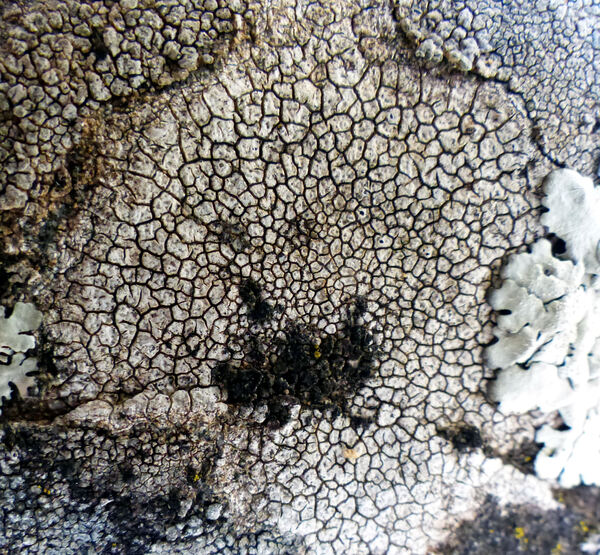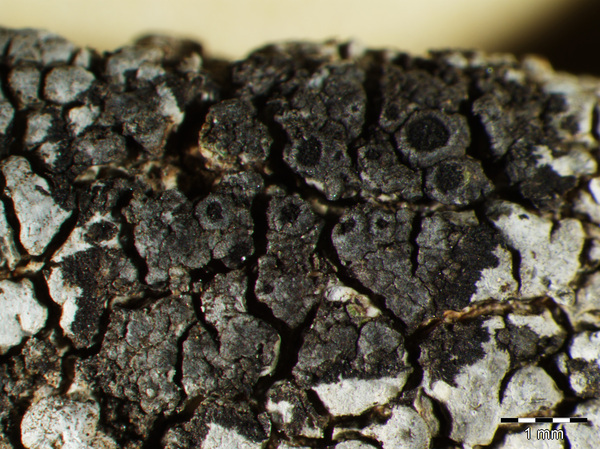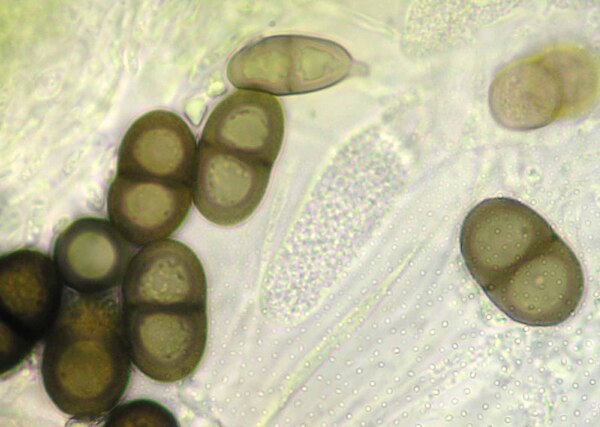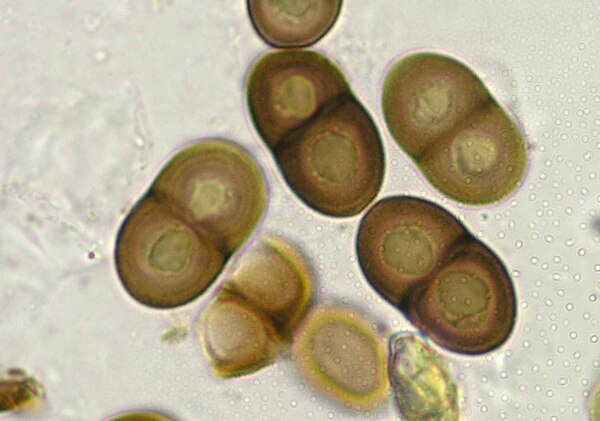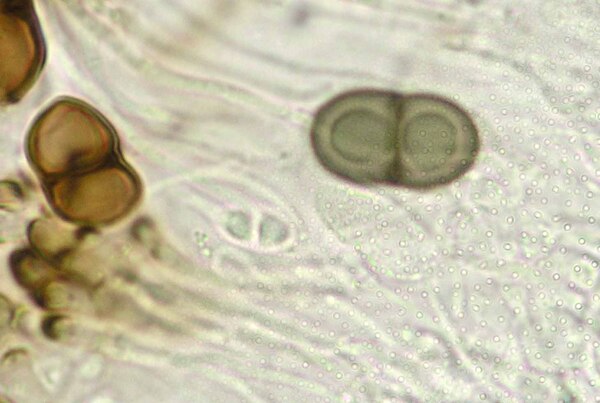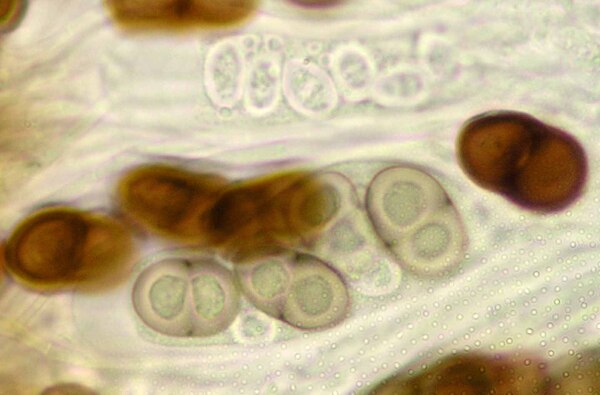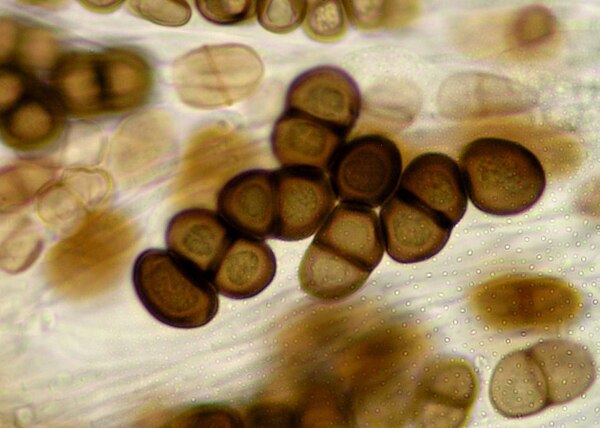Rinodina obnascens (Nyl.) H. Olivier
Bull. Acad. Int. Géogr. Bot., 12: 380, 1903. Basionym: Lecanora obnascens Nyl. - Flora, 69: 462, 1886.
Synonyms:
Distribution: N -TAA (Nascimbene & al. 2021), Lig. C - Tosc, Laz, Sar. S - Bas (Nimis & Tretiach 1999), Si (Pišút 1995, Iacolino & Ottonello 2006).
Description: Thallus crustose, thinly episubstratic, dark reddish grey to brown-black, rimose-areolate, isidiate-blastidiate, forming small islands on the thalli of (mainly) aspicilioid lichens. Areoles to 0.7 mm wide, developing on a black hypothallus, flat, with marginal, blackish, isidioid blastidia which may cover the whole thallus surface. Apothecia lecanorine, sessile and constricted at base, 0.3-0.8 mm across, with a dark brown to black, mostly flat disc, a smooth to blastidiate thalline margin, and a more or less evident parathecial ring. Thalline exciple 60-70 µm laterally, the cortex c. 10 µm thick, without an epinecral layer, without crystals; proper exciple to 10 μm wide laterally, 25-40 μm wide in upper part; epithecium dark red-brown, K-; hymenium colourless, 70-90 μm high, not inspersed with oil droplets; paraphyses 1.5-2(-3) μm thick at mid-level, the apical cells 3.5-6 μm wide; hypothecium colourless, up to 150 μm high. Asci 8-spored, clavate, the K/I+ blue tholus penetrated by a faintly amyloid apical cushion with parallel or diverging flanks, the wall K/I-, surrounded by a K/I+ blue outer layer, Lecanora-type. Ascospores 1-septate, brown, ellipsoid 13-21 x 7-12 μm, Milvina-type, the torus well developed, the walls ornamented. Pycnidia black, immersed. Conidia bacilliform, 3-4 x c. 1 μm. Photobiont chlorococcoid. Spot tests: thallus K-, C-, KC-, P-, UV-. Chemistry: without lichen substances. Note: a Mediterranean-Atlantic lichen found on weakly inclined to horizontal surfaces of siliceous rocks wetted by rain, starting the life-cycle especially on Aspiciliella intermutans, but sometimes on other lichens, e.g. Rhizocarpon-species; mostly Tyrrhenian in Italy, but also reported from the Alps.
Growth form: Crustose
Substrata: rocks
Photobiont: green algae other than Trentepohlia
Reproductive strategy: mainly asexual, by isidia, or isidia-like structures (e.g. schizidia)
Most common in areas with a humid-warm climate (e.g. most of Tyrrenian Italy)
paras Aspicilia spp. and other crustose lichens
Commonnes-rarity: (info)
Alpine belt: absent
Subalpine belt: absent
Oromediterranean belt: absent
Montane belt: extremely rare
Submediterranean belt: extremely rare
Padanian area: absent
Humid submediterranean belt: rather rare
Humid mediterranean belt: rare
Dry mediterranean belt: extremely rare

Predictive model
Herbarium samples
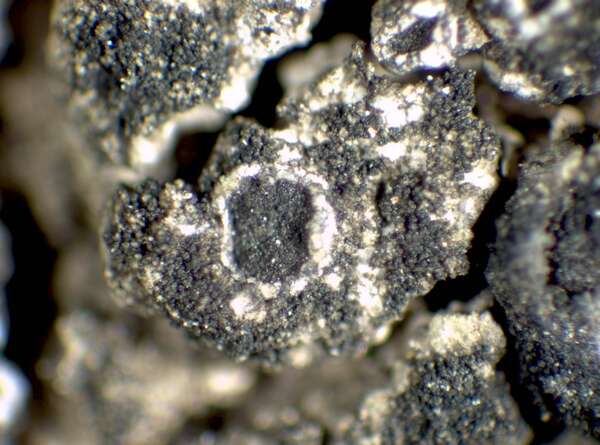

P.L. Nimis; Owner: Department of Life Sciences, University of Trieste
Herbarium: TSB (11756)
2001/12/18
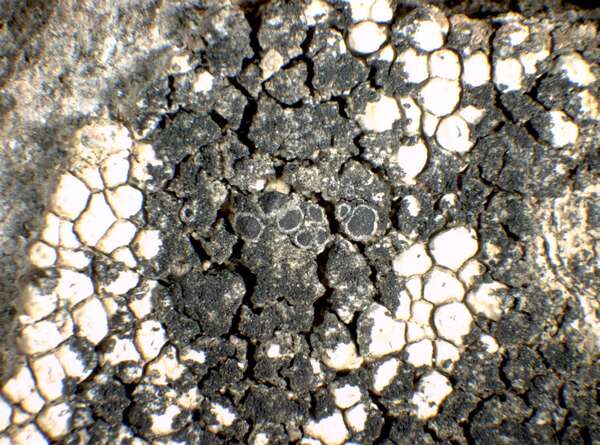

P.L. Nimis; Owner: Department of Life Sciences, University of Trieste
Herbarium: TSB (11756)
2001/12/18
on the host, Aspicilia intermutans
Growth form: Crustose
Substrata: rocks
Photobiont: green algae other than Trentepohlia
Reproductive strategy: mainly asexual, by isidia, or isidia-like structures (e.g. schizidia)
Most common in areas with a humid-warm climate (e.g. most of Tyrrenian Italy)
paras Aspicilia spp. and other crustose lichens
Commonnes-rarity: (info)
Alpine belt: absent
Subalpine belt: absent
Oromediterranean belt: absent
Montane belt: extremely rare
Submediterranean belt: extremely rare
Padanian area: absent
Humid submediterranean belt: rather rare
Humid mediterranean belt: rare
Dry mediterranean belt: extremely rare

Predictive model
| Herbarium samples |


P.L. Nimis; Owner: Department of Life Sciences, University of Trieste
Herbarium: TSB (11756)
2001/12/18


 INDEX FUNGORUM
INDEX FUNGORUM
 GBIF
GBIF
